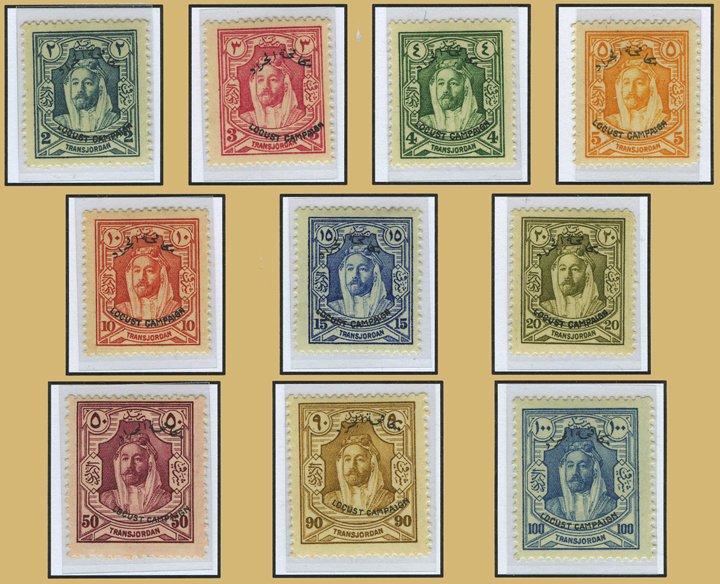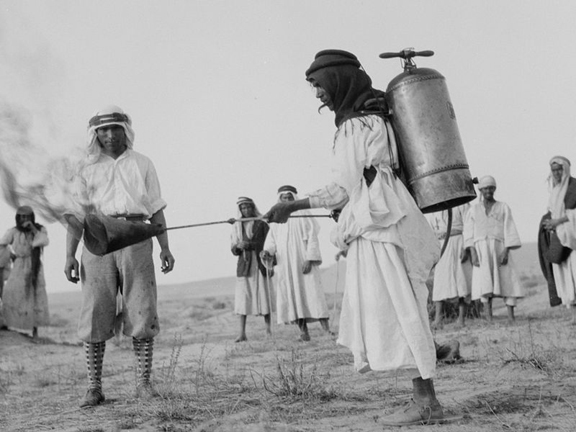Jordan
Anti-Locust Campaign Semi-Postal

The absence of a surcharge on this issue makes it an unusual semi-postal. It is likely that it was primarily produced for the philatelic market. The stamps were overprinted in Cairo on values from the Amir Abdullah ibn Hussein definitive issue of 1927-1929.
Regardless of the status of the stamps, there was an exceptional plague of locusts starting in 1929. The following account was provided in the Reading, Pennsylvannia Eagle:
Man's age old fight with the insect hordes of Africa, a struggle in which he has sometimes come out second best, is a perennial combat in this region. Each year an army of men, armed with flame-throwers and chemicals, attacks and defeats tremendous masses of grasshoppers. The next year they must fight the battle all over again.
Although the hoppers, which are really true locusts, have been descending upon the grain fields of Algiers. Egypt and Palestine since the dawn of history and made 1930 no exception to their rule of invasion, their life habits are not yet fully understood. One school of scientific thought believes that because they breed amid the sparse vegetation of wild areas, they seek new pastures when that is devoured, taking to the air when the young attain wings, in such numbers as to cloud the sun. Another theory is that the migratory instinct is preliminary to maturity. When that stage is reached, the insects settle, breed and feed. Those who hold to this theory assert that the hoppers do not stop for food and then resume flight, but quit the air only when instinct halts them.
Algeria alone spent $1 000 000 killing grasshoppers in 1929 and 60 000 civilians and three regiments of troops formed skirmish lines along the north African coast during the height of the Fall invasion of the insects. Since then the pests have descended upon the cotton fields of Egypt, crossed the Sinai peninsula and attacked the farms of Palestine.
Flame-throwers, used exactly as in war, have been successful in Algiers. Soldiers with tanks on their backs sometimes burn thick carpets of grasshoppers that cover several square miles. An older method, still used, is to erect mile-long barricades of metal sheets to divert the advancing pests toward deep trenches and holes where burning gasoline or chemicals kill them. In some places natives advance with a strip of canvas a yard or so wide and several hundred feet long, shaking it constantly to force the grasshoppers into trenches. So far the annual campaign against the pest has been a mere elaboration of old native methods. The pest afTects not only northern Africa, but South and Central America, southern and southeastern Europe and parts of Asia Minor. It also attacked the prairie wheat lands of the United States, but advancing cultivation destroyed its breeding grounds.
Despite measures taken to control the locusts, the plague extended from 1928-1942. It was particularly devastating in 1930 because four species of locusts: the desert locust, African migratory locust, red locust and brown locust, attacked simultaneously.

Flame thrower being used to eradicate locusts in the Ottoman Empire in 1915
(Public Domain from upload.wikimedia.org/wikipedia/commons/9/93/Flaming_Locusts_in_1915.jpg)
Bibliography
Darlow, Major J.J. "Kissing the Locust." Gibbons Stamp Monthly. Vol. 3 Iss. 11. Aug. 1930: 206-207.
"Jordan." Standard Postage Stamp Catalogue. 2008.
"Locusts ready to devour all vegetation in Africa." Lodi News Sentinal. 16 May 1966: p30. Web.
"Wages Age Old War on Insect Pests in Africa." Reading Eagle. 11 May 1930: p4. Web.
Direct comments, questions and corrections to:
stampquestions@hotmail.com
© Grose Educational Media, 2015
|